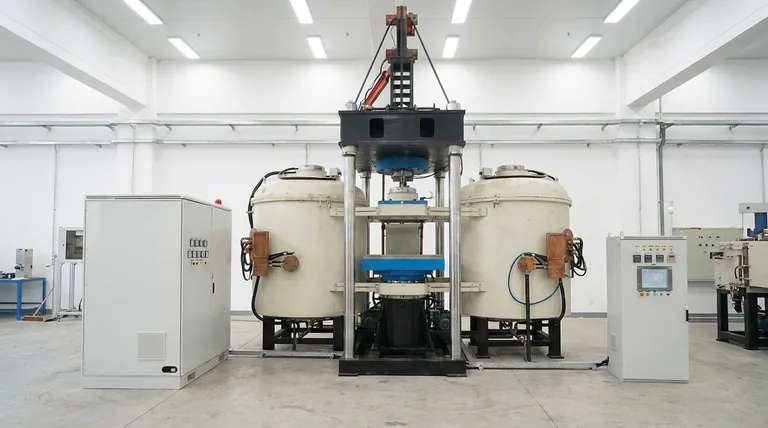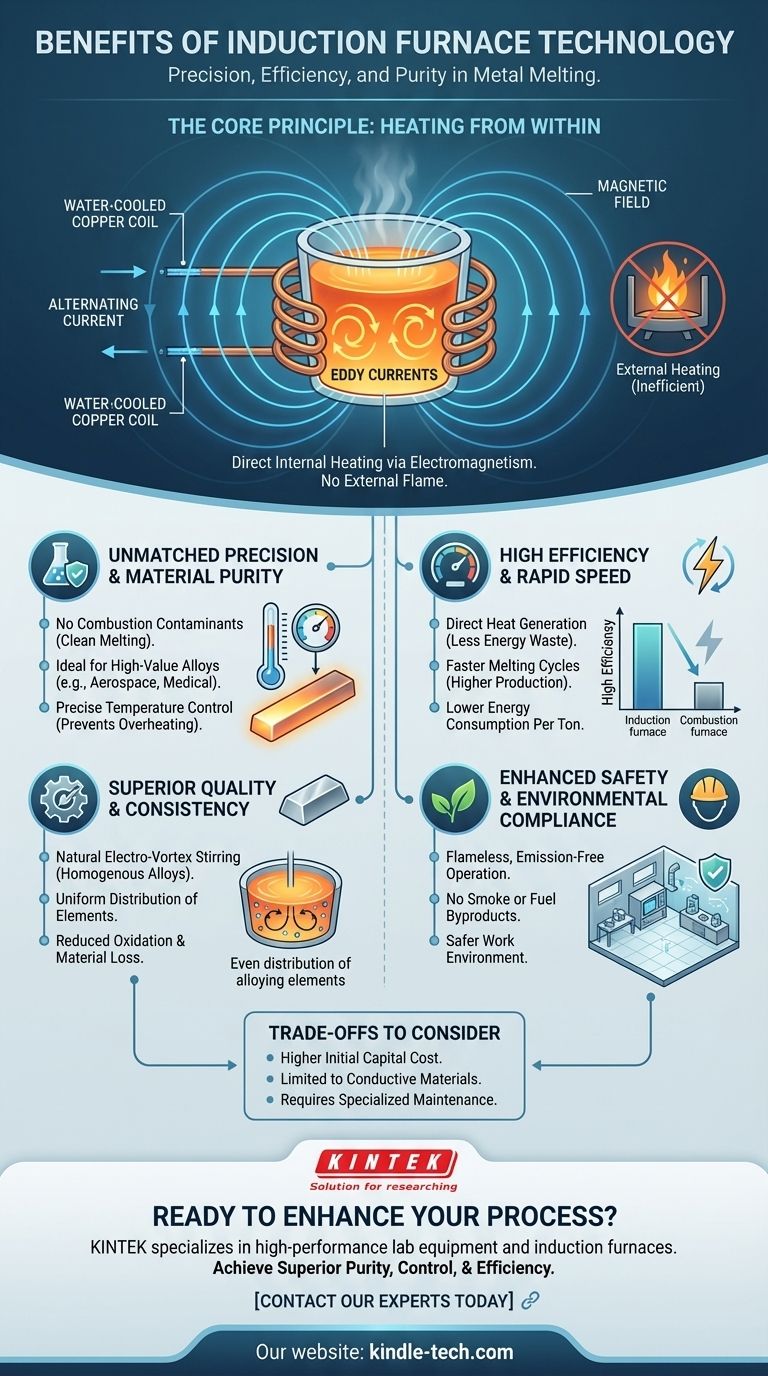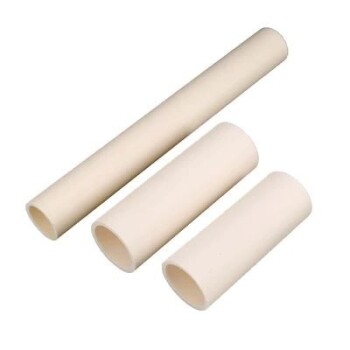The primary benefits of an induction furnace are its exceptional precision, high energy efficiency, and its clean, safe method of operation. Because it generates heat directly within the metal charge using electromagnetism instead of an external flame or arc, it offers unparalleled control over the entire melting process, resulting in higher quality products and a safer work environment.
Unlike traditional furnaces that heat from the outside in, an induction furnace uses electromagnetism to generate heat within the material itself. This fundamental difference is the source of its core advantages in control, speed, and purity for metallurgical applications.

The Core Principle: Heating from Within
The unique advantages of induction technology stem directly from its method of heating. It is not an incremental improvement over older methods; it is a fundamentally different approach.
How Electromagnetic Induction Works
An induction furnace utilizes a powerful, water-cooled copper coil. A high-frequency alternating current is passed through this coil, creating a dynamic and powerful magnetic field.
When a conductive material, such as metal scrap or ingots, is placed inside this field, the magnetic field induces strong electrical currents (known as eddy currents) within the metal itself. The metal's natural resistance to these currents generates intense, rapid, and precise heat.
The Impact on Speed and Efficiency
Because the heat is generated inside the charge, the melting process is remarkably fast and energy-efficient. There is very little wasted energy heating the furnace chamber or the surrounding air, as is common with combustion-based systems.
This direct heating method leads to significantly higher production efficiency and lower overall energy consumption per ton of metal melted.
Unmatched Precision and Material Quality
For applications involving valuable alloys or strict metallurgical specifications, control is paramount. Induction furnaces provide a level of control that combustion furnaces cannot match.
Preventing Contamination
The process is entirely free of combustion. There are no flames, smoke, or fuel byproducts to introduce impurities like carbon or sulfur into the melt.
This makes it the ideal choice for applications where metal purity is a critical concern, such as in aerospace, medical, or specialty alloy manufacturing.
Minimizing Oxidation and Element Loss
The precise and rapid temperature control prevents overheating. This minimizes the loss of valuable and easily oxidized alloying elements.
With no direct flame impinging on the metal, both oxidation and decarburization are drastically reduced, saving material and ensuring the final product meets its chemical specifications.
Ensuring Alloy Homogeneity
The electromagnetic field that heats the metal also creates a natural stirring action within the molten bath. This electro-vortex effect ensures that all alloying elements are distributed evenly, resulting in a perfectly uniform and homogenous final product.
Understanding the Trade-offs
While induction technology offers significant advantages, it is essential to understand its specific operational context and limitations.
Higher Initial Capital Cost
The advanced power electronics, precision coils, and cooling systems required for an induction furnace typically result in a higher upfront investment compared to simpler, fuel-fired furnaces.
Material Constraints
Induction heating is only effective on electrically conductive materials. It is the ideal technology for metals but is not suitable for melting non-conductive materials like glass or certain ceramics.
Maintenance Complexity
The high-frequency power supplies and water-cooling circuits are sophisticated systems. They require specialized knowledge for proper maintenance and repair, which can be a consideration for some facilities.
Making the Right Choice for Your Application
Selecting the right furnace technology depends entirely on your operational priorities and the materials you are processing.
- If your primary focus is high-purity alloys or specialty metals: The contamination-free, precision-controlled melting environment of an induction furnace is non-negotiable.
- If your primary focus is high-volume production and efficiency: The rapid heating cycles, low energy consumption, and reduced material loss offer a compelling return on investment.
- If your primary focus is workplace safety and environmental compliance: The flameless, emission-free operation makes the induction furnace the superior choice for a modern industrial facility.
Ultimately, adopting induction furnace technology is a strategic decision to prioritize material quality, operational efficiency, and a safer, cleaner work environment.
Summary Table:
| Benefit | Key Advantage |
|---|---|
| Material Purity | No combustion contaminants; ideal for high-value alloys. |
| Process Control | Precise temperature regulation and natural stirring action. |
| Energy Efficiency | Direct internal heating minimizes energy waste. |
| Operational Safety | Flameless, emission-free operation enhances workplace safety. |
Ready to enhance your metal melting process with precision and efficiency?
KINTEK specializes in high-performance lab equipment, including induction furnaces designed for superior results. Our solutions deliver the purity, control, and efficiency your laboratory demands, ensuring you achieve the highest quality outcomes for your specialized alloys and metals.
Contact our experts today to find the perfect induction furnace for your application and discover how we can support your laboratory's success.
Visual Guide

Related Products
- 600T Vacuum Induction Hot Press Furnace for Heat Treat and Sintering
- 1700℃ Laboratory Quartz Tube Furnace with Alumina Tube Tubular Furnace
- Ultra-High Temperature Graphite Vacuum Graphitization Furnace
- 1800℃ Muffle Oven Furnace for Laboratory
- 1700℃ Muffle Oven Furnace for Laboratory
People Also Ask
- Can you get an electrical arc in vacuum? How High Voltage Creates Plasma in a Void
- What is the effect of increasing the pressure during sintering? Achieve Maximum Density and Superior Performance
- What does bond strength depend on in braze welding? Master the 3 Keys to a Strong Joint
- What is vacuum hot pressing? Achieve Maximum Density & Purity in Advanced Materials
- Is brazing or welding cheaper? A Detailed Cost Analysis for Your Project



















